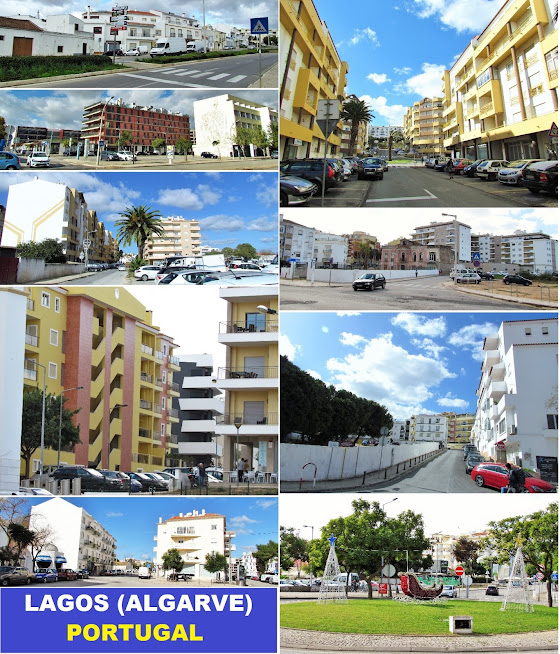LAGOS
N 37° 6′ 10″; W 8° 40′ 22″
Lagos is a Portuguese city in the district of Faro, a region and sub-region of the Algarve, with about 27 949 inhabitants. It is located in Barlavento Algarvio (the western part of the Algarve).
It is the seat of a municipality with an area of 212.99 km² and 31 049 inhabitants (2011), subdivided into 4 parishes. The municipality is limited to the north by Monchique, to the east by Portimão, to the west by Vila do Bispo, to the northwest by Aljezur and to the south by a coastline on the Atlantic Ocean.
Lagos is historically associated with the Portuguese Discoveries, being today one of the most attractive tourist centers in the Algarve, with exceptional beaches and cultural and religious heritage, as well as a highly dynamic nightlife. Currently, the majority of the population resides dispersed in the territory of the municipality, outside the historic center of the city, working mainly in the services and tourism industry. The historic center is practically all pedestrian, offering a wide range of commercial or cultural establishments, restaurants, bars, and cafés to visit.
It is the seat of a municipality with an area of 212.99 km² and 31 049 inhabitants (2011), subdivided into 4 parishes. The municipality is limited to the north by Monchique, to the east by Portimão, to the west by Vila do Bispo, to the northwest by Aljezur and to the south by a coastline on the Atlantic Ocean.
Lagos is historically associated with the Portuguese Discoveries, being today one of the most attractive tourist centers in the Algarve, with exceptional beaches and cultural and religious heritage, as well as a highly dynamic nightlife. Currently, the majority of the population resides dispersed in the territory of the municipality, outside the historic center of the city, working mainly in the services and tourism industry. The historic center is practically all pedestrian, offering a wide range of commercial or cultural establishments, restaurants, bars, and cafés to visit.
PONTA DA PIDEDADE
37.081458, -8.669562
Ponta de Piedade is a geographical feature near the city of Lagos, in the Algarve region, in Portugal. It is made up of a cape surrounded by several cliff-type rock formations, up to around 20 m high, making it one of the most interesting tourist attractions in the region.
Description
Ponta da Piedade is one of the main tourist attractions, both in the municipality of Lagos and at a regional level, possessing a valuable set of historical, natural, scenic and geological heritage.
On site, it is possible to visit the various existing caves, guaranteeing a pleasant and unique tourist experience.
Access by land: from the Ponta da Piedade Lighthouse and then on foot through stairs carved into the slopes.
Access by sea: at the Lagos marina, excursions to Ponta da Piedade are offered by sailing boat or small fishing boats.
The top of the cliff, at Ponta da Piedade cape, reaches around 40 m in height.
History
Early formation and occupation
The rock formations were formed from marine erosion, with the terrain being mainly composed of rocks formed around 20 to 7 million years ago, during the Miocene period, when the entire area was still covered by sea waters, with the coastal strip several kilometers inland. The promontory has great paleontological potential, with the teeth of large sharks, traces of several extinct species of fish, and coral fossils having been discovered.
Since ancient times, Ponta da Piedade has had a cultural and religious function, having been considered a sacred place due to its connection to the ocean. In fact, human occupation on the promontory may be very old, with Bronze Age pieces having been collected on the ground, while underwater remains from the Roman period were discovered, such as ruins, the base of a column, and coins.
16th to 20th centuries
In the 16th century, a hermitage dedicated to Nossa Senhora da Piedade was built, although evidence of previous buildings was found on the site. One of the main reminders of the religious importance of Ponta da Piedade is a ceremonial route from the city of Lagos, known as Via Sacra, with the landmarks of the stations of the cross still remaining. The cape also had great importance as a point of surveillance and defense of the coast, with a military battery being installed there in 1663, which was rebuilt in the second half of the 18th century and closed in 1821. Subsequently, the hermitage was demolished to install the lighthouse, whose works took place between 1912 and 1913.
In 2015, a team of travel experts from the online newspaper The Huffington Post visited ten beaches in various tourist spots around the world, with Ponta da Piedade being chosen by collaborator Suzy Strutner as her favorite, due to its natural beauty, with the rock formations. In 2020, travel guide publisher Lonely Planet highlighted Ponta da Piedade as one of the ten natural wonders in Portugal.
💓💓💓💓💓
SEARCH IN ALPHABETICAL ORDER
IN THE DISTRICT OF FARO
💓💓💓💓💓
Return to mainland Portugal &
the Azores and Madeira islands



















































































































